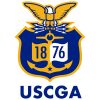Thomas DeNucci, D.Eng, Commander, USCG (ret)

After graduating from the U.S. Coast Guard Academy in 1998 with a degree in Electrical Engineering, Tom DeNucci was assigned to the office responsible for overseeing the construction, outfitting and delivery of the Coast Guard Cutter Healy, the nation’s largest and most technologically advanced icebreaker.
The assignment provided him with the opportunity to become involved in the final stages of ship design and construction. A year later, Dr. DeNucci reported aboard Healy as a plank-owner and served as the Damage Control Assistant and the Electrical Officer.
Now retired from the Coast Guard after a 20+ year career, Dr. DeNucci serves as an instructor in the Naval Architecture and Marine Engineering (NAME) program. The cadets that he and his colleagues teach focus on the design and analysis of ships and boats, and the systems that help them operate. Graduates of the program contribute to the solution of engineering challenges such as the construction, safe operation, sustainment, management, and repair of one of the Coast Guard’s main assets – its fleet of more than 240 large vessels, called cutters.
Dr. DeNucci and his colleagues in the NAME team are looking for those students who might follow in his footsteps and do a deep dive into the next generation of cutters now being commissioned into service that Academy graduates will be serving on for years to come.
Education
- D.Eng, Naval Architecture and Marine Engineering, Delft University of Technology, May 2012
- Systems Engineering Certificate, Naval Postgraduate School, 2009
- M.S., Naval Architecture and Marine Engineering., Massachusetts Institute of Technology, June 2005
- M.S., Mechanical Engineering, Massachusetts Institute of Technology, June 2005
- B.S., Electrical Engineering, U.S. Coast Guard Academy, May 1998
Courses Taught
- Ship Design/System Integration
- Principles of Ship Design
- Ship Propulsion Design
- Principles of Naval Architecture
- Marine Engineering
- Advanced Engineering Math
- Fluid Mechanics
- Dynamics
- Mechanics of Materials
- Statics and Engineering Design
Ship Design Projects
- 2016 – Redesigning the USCG Inland Tender Fleet: A Comprehensive Design Strategy for Replacing the WLIC/WLR Classes
- 2015 – Design of the Modular Patrol Cutter: An Affordable Solution for Replacing the USCG Medium Endurance Fleet
- 2014 – Arctic Patrol Cutter Design: Protecting U.S. National Interests in the Arctic Region
- 2013 – Designing Polar Icebreaking Vessels: Nuclear, LNG and Conventionally Powered Options
- 2012 – U.S. Coast Guard Offshore Patrol Cutters: Design for “X”
- 2011 – Designing a Mobile Offshore-Base: Mission and Logistics Sustainment for a Fleet of At-Sea Vessels
Selected Publications and Presentations
- DeNucci, T., Britton, A., Daeffler, M., Sabra, G. and Hopman, J., “Multi-Objective Design Study for Future U.S. Coast Guard Icebreakers,” 13th International Conference on Computer Applications and Information Technology in the Maritime Industries, Lecce, IT, May 2016.
- DeNucci, T., Simione, L. and Hopman, J., “Optimization-based approach to rationale capturing in ship design,” 12th International Conference on Computer Applications and Information Technology in the Maritime Industries, Ulrichschusen, GER, May 2015.
- Swithenbank, S. and DeNucci, T. “Combining the Flipped Classroom with Traditional Teaching in Undergraduate Newtonian Dynamics,” Journal of Online Engineering Education, Vol. 5, No. 2, 2015.
- Swithenbank, S. and DeNucci, T. “Using a ‘Flipped Classroom’ Model in Undergraduate Newtonian Dynamics,” ASEE Annual Conference, Indianapolis, IN, 2014.
- DeNucci, T. and Hopman, J. “Capturing configuration rationale in complex ship design (1),” SWZ Maritime (Maritime Technical Journal), 133:31-37, 2012.
- DeNucci, T. and Hopman, J., “Capturing configuration rationale in complex ship design: Methodology and test case results”, 11th International Marine Design Conference, Glasgow, UK, June 2012.
- DeNucci, T., Capturing Design: Improving conceptual ship design through the capture of design rationale, PhD Thesis, Delft University of Technology, 2012.
- Van Bruinessen, T., Hopman, H., DeNucci, T. and van Oers, B., “Generating more valid designs during design exploration, Journal of Ship Production and Design, 27(4): 153-161, 2011.
- DeNucci, T. and Hopman, J., “Optimization-based approach to rationale capturing in ship design,” 9th International Conference on Computer Applications and Information Technology in the Maritime Industries, Gubbio, IT, April 2012.
- DeNucci, T., Hopman, J. and van Oers, B., “Prototype development of a ship rationale capture tool”, 16th International Conference of Ship and Shipping Research, Messina, IT, November 2009.
- DeNucci, T., Hopman, J.. and van Oers, B., “Capturing trade-off rationale during design selection,” 8th International Conference on Computer Applications and Information Technology in the Maritime Industries, Budapest, HUN, April 2009.
- DeNucci, T., “Diagnostic indicators for shipboard monitoring systems using non-intrusive load monitoring”, M.Sc. Thesis, Massachusetts Institute of Technology, June 2005.
- T. W. DeNucci, et al., “Diagnostic Indicators for Shipboard Systems Using Non-Intrusive Load Monitoring,” IEEE Electric Ship Technologies Symposium, July 2005.
- W. C. Greene, et al., “Non-Intrusive Monitoring for Condition Based Maintenance,” U.S. Coast Guard Engineering, Electronics & Logistics Quarterly, Summer 2005.
- J. S. Ramsey, et al., “Shipboard Application of Non-Intrusive Load Monitoring,” ASNE Conference on Reconfiguration and Survivability Symposium, Feb. 2005.
Professional Memberships
- Society of Naval Architects and Marine Engineers (SNAME)
- American Society of Naval Engineers (ASNE)
